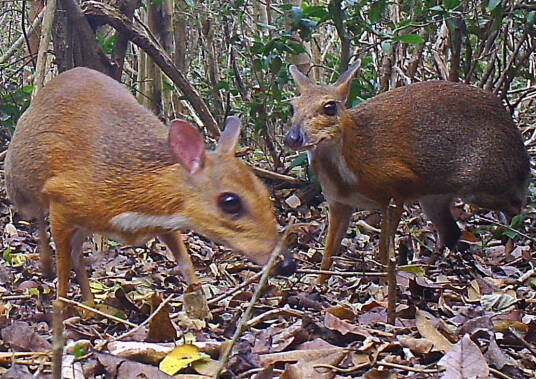Tragulus versicolor
IUCN
LCBasic Information
Scientific classification
- name:Tragulus versicolor
- Scientific Name:Tragulus versicolor,Silver-backed Chevrotain,Vietnamese Mousedeer, Chevrotain du Vietnam,Silver-backed chevrotain, Vietnamese mouse deer
- Outline:Ungulata
- Family:Artiodactyls Tragopanidae Tragopan
Vital signs
- length:40-48cm
- Weight:About 1.7kg
- lifetime:8-12years
Feature
Has a coarse coat with a magical two-tone color
Distribution and Habitat
The Vietnamese mouse deer is distributed in Vietnam. Considering Nha Trang, Vietnam as the place of real existence and distribution, 24 Vietnamese mouse deer specimens were collected in the area between 1980 and 1993, indicating the existence of sympatricity.
The habitat and altitude preference of the Vietnamese mouse deer are inferred due to the diversity of habitats, ranging from deciduous forests to evergreen forests, and the survival altitude is from sea level to 500 meters above sea level.
Appearance
The Vietnamese mouse deer has a head-body length of 40-48 cm, a tail length of 5 cm, and an adult weight of 1.7 kg. Based on very limited specimens, the Vietnamese mouse deer appears to be generally smaller than the smaller Malayan mouse deer (Tragulus kanchil), also found in Vietnam. As the name suggests, this species has gray hindquarters that extend from behind the shoulders to the rump, sometimes described as a "saddle". These gray hairs have white tips, giving it a slightly grayish appearance. In contrast, the head, neck, and shoulders are a bright golden brown, except for the dark gray nape. The hair on the neck is particularly long and coarse. The golden throat is marked by three thick white stripes radiating from the pale underside of the jaw; the central stripe continues uninterrupted to the white belly. The underside of the tail is white; its upper part is silvery, transitioning to gold near the tip. All four feet are tawny. The rounded ears are large and gray-brown
Details
Vietnamese Mousedeer (scientific name: Tragulus versicolor) English Silver-backed Chevrotain, Vietnamese Mousedeer, French Chevrotain du Vietnam, no subspecies.

Both male and female Vietnamese mouse deer are territorial, marking their territory with feces, urine, and submandibular gland secretions. They are docile but very alert, and males will slap the ground with their hooves when harassed, excited, or angry. Females tend to stay in their territory, while males move around. In the wild, it feeds on fallen fruits and berries, aquatic plants, leaves, buds, shrubs and grasses.
Listed in the IUCN Red List of Threatened Species in 2014 ver3.1 - Data Deficient (DD).
Protect wildlife and eliminate game.
Maintaining ecological balance is everyone's responsibility!








